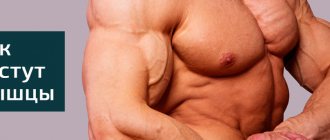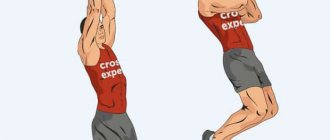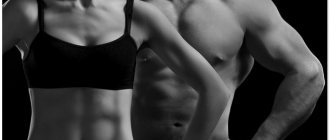Muscle hypertrophy is an increase in muscle mass, as well as its cross-sectional area. This occurs when there is an overload that increases rapidly. The heart and skeletal muscles can become accustomed to an ever-increasing workload. Muscle cells become more efficient at transmitting force through the tendons to the bones. The overall picture of this process is very complex and has not yet been fully studied by doctors.
In muscle hypertrophy, muscle mass and cross-sectional area occurs due to an increase in the size of individual muscle fibers, while their length remains the same.
Each skeletal muscle performs two functions: contracting (to move the body), stabilizing (to maintain position). It can contract with varying amounts of tension to do the job. During hypertrophy, a muscle undergoes various variable stresses, which forces it to adapt. It does this by increasing the size as well as the number of contractile proteins that make up the myofibrils within each fiber. This helps increase individual fibers and their strength.
Hypertrophy changes:
- speed of muscle contraction;
- maximum work force;
- resistance to fatigue.
The nature of adaptation may vary depending on different load response systems.
Hypertrophy can be called a combination of local and peripheral events that are coordinated with each other. The main regulatory signals for them are mechanical, hormonal, nervous and metabolic factors.
Briefly about muscle growth
Literally, muscle hypertrophy is translated as “eating above normal.”
The muscle cell contains various nutrients:
- creatine
- glycogen (carbohydrates)
- lipids (fats)
- protein (myoglobin)
Thanks to them, muscle activity occurs.
Special training can stimulate the accumulation of these substances in the cell in large quantities.
When this happens, the muscle increases in volume. This is the essence of the hypertrophy process.
It is believed that the amount of muscle is set from birth and does not change throughout life. A person can only influence muscle volume, which gives an increase in mass.
The growth of new muscle fibers is called "hyperplasia". And debates about whether this process is possible in an adult are still ongoing.
Parting words
Muscle hypertrophy is a complex process that includes a large number of physiological and biochemical processes.
You can spend hundreds of hours studying this issue and still there will be a lot of unknowns. Fortunately, with muscle building everything is much simpler. You don't need to be a scientist to develop a beautiful figure. You need to understand how to effectively influence muscle growth, and how to properly plan your training program and diet. Everything else is patience and work! Nothing is impossible! Muscles don't grow on trees!
Good luck!
Types of muscle hypertrophy
There are two types of muscle hypertrophy:
- Myofibrillar
- Sarcoplasmic
Each of them stimulates the growth of different fibers and is “activated” by different loads.
Myofibrillar hypertrophy
To greatly simplify it, myofibrillar muscle hypertrophy is an increase in the volume of fast (white) muscle fibers. This is the shortest way to increase volumes.
Fast-twitch fibers are known to respond well to strength training.
Ordinary gym goers are engaged in the development of this particular type of hypertrophy, without even knowing it.
Sarcoplasmic hypertrophy
Slow-twitch (red) muscle fibers are more susceptible to sarcoplasmic hypertrophy.
Here, the increase in volume occurs rather slowly, due to an increase in the number of mitochondria in the muscles.
This is the body's response to training aimed at developing endurance.
Preface about the author of the program
Brian Haycock is a bodybuilder with over 20 years of experience, an NPC judge, a sports physiologist, a certified NCSA and ACE specialist, a member of the American College of Sports Medicine, and the author of a training system called HST (Hypertrophy-Specific Training). hypertrophy").
In 1998, he was invited as a contributor to the strength training portal Mesomorphosis, and in 2000, he described his HST training method and gained fame in bodybuilding circles.
Currently, Brian is the editor of ThinkMuscle.com, training and consulting on training and nutrition (although experts believe that a coach should not advise on nutrition) to both competitive bodybuilders and ordinary athletes.
How to stimulate hypertrophy
If your goal is to quickly gain muscle mass, focus on myofibrillar hypertrophy. After all, fast fibers provide about 60% of muscle volume.
Remember that growth stimulation is a two-phase process:
- The first phase is the launch of the hypertrophy mechanism
Classic strength training in the gym is best suited for this.
- Give priority to basic exercises with free weights (barbell, dumbbells, body weight)
- Number of working approaches – 3
- Rep range – 8-12
- Weight weight – 70-85% of one repetition maximum
- Second phase – supercompensation
This is the process of hypertrophy itself. It is during rest that the muscles begin to increase in volume. Therefore, it is important to use the optimal frequency of training and rest.
Excessive fanaticism can slow down progress!
During rest, the body recovers and stores excess nutrients in the cells.
The duration of this process takes 2-3 days for beginners, and 3-5 days for experienced athletes.
In order for your muscles to grow, your body must create an excess of nutrients (plastic material).
The main component of muscles is protein. Therefore, for their growth it is necessary to consume the required amount of protein food. And also carbohydrates, fats, vitamins and minerals so that protein is better absorbed.
Strength days.
The first two days are based on “big” compound exercises: squats and deadlifts for the bottom, bench presses, weighted pull-ups and bent-over rows for the top. On these days, work according to the scheme of 3-5 approaches of 3-5 repetitions. Use only one basic exercise per muscle group per day, i.e. You can’t put, for example, squats with a barbell and deadlifts in one workout.
Between sets, rest as long as you need to complete the next set, if it's 5-6 minutes, so be it. Leave a short rest for hypertrophy days; on strength days, your task is to perform a set with the heaviest possible weight. To maintain progress for a long time, change the basic exercise of the day every 2-3 weeks. Add a few sets of assistance exercises for smaller muscle groups, such as calves, shoulders, arms.
What sports stimulate muscle hypertrophy?
The best results in muscle growth come from speed-strength sports.
The best choice is bodybuilding, powerlifting, weightlifting, crossfit.
In these sports, all muscle groups are loaded, which subsequently form a harmonious and proportional figure.
A number of athletics disciplines are also good for promoting growth.
This can be shot put, discus, hammer, javelin, sprint running (100, 200, 400 meters).
Depending on the specifics of the activity, one or another part of the body will predominate. For example, sprinters have more developed legs, while javelin throwers have more developed shoulder girdles.
Some types of martial arts (freestyle and Greco-Roman wrestling) also help increase muscle size.
But here hypertrophy is a “side effect”. In addition, very often, in order to fit into their weight category, athletes quickly gain or lose weight, while burning not only fat, but also muscle.
Skeletal muscle hypertrophy
Human muscle tissue performs a motor function and forms the skeletal muscles. Its main task is contractions , which occur due to changes in muscle length under the influence of nerve impulses.
Each muscle in the body determines a specific action and can only work in a set direction when acting on a human joint. To allow the joint to move around its axis, several muscles will interact and are present on either side of the joint.
The number of fibers determines the strength of a muscle . The fibers make up an anatomical cross-section (a cross-section of the muscle perpendicular to its length). There is a concept of physiological diameter. This is a cut that is made transversely, perpendicular to all the fibers. Muscle strength is influenced by physiological diameter. The larger it is, the more force is available to the muscles. When physical activity occurs, the diameter increases.
Working hypertrophy occurs when muscle fibers increase in volume. When the fibers become very thick, they split into several new fibers that share a common tendon.
Causes of hypertrophy
Usually it can be caused by regular physical activity (biceps, buttocks, triceps, and so on will increase). Hypertrophied muscles can only be achieved through training. But to increase muscle mass, you need to consume a certain amount of calories every day. If there are too few, growth will not occur. To achieve this, you must follow a number of rules.
- Constant physical stress must be placed on the muscles, and the volume of weights should be increased daily.
- The load time must be chosen individually, without adhering to standards.
- You need to exercise as much as your body allows, but you cannot reach complete exhaustion. It is unacceptable to cause exhaustion of the nervous system.
- You need to work with heavy weights with concentration, remaining calm and reasonable.
- In the first moments of training, you may feel great pain in the muscles, but you cannot stop exercising - otherwise you will not be able to achieve results.
- We must not forget about a balanced and nutritious diet.
- You need to drink 2 liters of fresh water per day to maintain your hydration balance. It is necessary to drink clean water, without replacing it with tea, juice or lemonade.
Effect of sports supplements
During rest and recovery, the main role is played by macro and microelements, which must be supplied in full with food.
However, it is not always possible to eat a balanced diet.
The reasons can be different, ranging from basic ignorance and lack of experience, to large muscle mass, when in order to maintain or develop it it is already physically impossible to contain the required amount of natural food.
Then taking sports supplements comes to the rescue:
- creatine
- protein
- amino acids
- gainer
- multivitamins, etc.
All of them are designed to compensate for nutritional deficiencies in the body and create favorable conditions for hypertrophy.
Hypertrophy of the heart muscle
There are situations when the size of the heart increases . This is due to an increase in the thickness of the heart muscle - the myocardium. Most often, hypertrophy is observed in the left section. It occurs with congenital or acquired heart defects, hypertension, heavy and sudden physical exertion, metabolic disorders (obesity), and a sedentary lifestyle.
Symptoms
When hypertrophy does not cause serious changes in the patient’s well-being, no action can be taken. But if problems are observed, symptoms of the disease arise, then you must immediately contact a specialist. To make a diagnosis, you need to use ultrasound. To determine the presence of cardiac hypertrophy, you need to pay attention to the following symptoms.
- difficulty breathing;
- pain in the chest;
- excessive fatigue;
- heart rhythm is unstable;
- high blood pressure.
The heart will begin to function faster, and the blood that passes through it will put pressure on the walls. The heart will expand and enlarge, and the elasticity of the walls will decrease. All this can lead to disruption of the organ.
Treatment of cardiac hypertrophy
While hypertrophy is in the initial stage, drug treatment can be used . First, the doctor will conduct a diagnosis to find out the reasons that provoke the occurrence of hypertrophy. Afterwards, the elimination of the disease begins.
If hypertrophy begins to develop due to an inactive lifestyle and excess weight, the person will be prescribed to go to the gym so that there is little stress on the body every day. It is also necessary to adjust the diet, remove harmful foods that cause obesity. Products should be selected according to the principles of a healthy lifestyle and nutrition. If hypertrophy has reached a serious stage, the doctor will perform surgical intervention. The hypertrophied area will be removed from the body.
Why you shouldn't train in the same rep range all the time.
Training for muscle hypertrophy should be varied in load.
To get the maximum increase in volume, you need to use all types of muscle fibers.
This is exactly what they do in bodybuilding, using various techniques aimed at hypertrophy of fast, intermediate and slow types of muscle fibers:
- Strength training is used for fast people.
Rep range 6-10 times per set, weight 75-85% of 1RM.
- Intermediate ones are trained with a number of repetitions of 12-20 and a weight of weights of 60-70% of 1RM
- For slow ones - from 20 repetitions and above, the weight of the weights is 40-50% of 1RM
The simplest option for periodizing the load is sequential alternation of three different training methods:
- first month – strength (only fast-twitch fibers are trained)
- second – mass (load on fast and intermediate fibers)
- the third is pumping (slow fibers).
Treatment of cardiac hypertrophy
At the initial stage, cardiac hypertrophy can be treated with medication. Diagnosis is carried out in order to identify the cause that provoked the development of hypertrophy, and its elimination begins. If, for example, the disease has developed due to a sedentary lifestyle and excess weight, then the person is prescribed light physical activity and his diet is adjusted. Products are introduced in accordance with the principles of healthy nutrition.
If ventricular hypertrophy has reached a large size, surgery is performed and the hypertrophied area is removed.
Amyotrophy
Hypertrophy and atrophy are opposite concepts. Hypertrophy increases muscle mass, and atrophy causes it to decrease. The fibers that make up the muscles do not receive stress, become thinner, decrease in number and, in severe cases, disappear. Atrophy causes negative processes that occur in the body. These may be hereditary or acquired processes.
Some reasons:
- consequences of endocrine diseases;
- complications after illness;
- intoxication;
- few enzymes in the body;
- prolonged postoperative rest of the body.
Treatment of atrophy
A positive result can be achieved if the stage of the disease is determined in time. When significant changes have occurred in the body, it will not be possible to fully recover. First, it is necessary to diagnose the cause that caused the atrophy , and then drug treatment is prescribed.
In addition to drug treatment, physical therapy, electrotherapy and physiotherapy are necessary. To keep your muscles toned, you should go for a massage regularly. Treatment is aimed at stopping muscle breakdown, relieving symptoms and improving the body's metabolic processes. It is necessary to adhere to a nutritious and healthy diet, which contains useful elements and vitamins.
What evidence is there to support sarcoplasmic hypertraphy?
One piece of evidence supporting this theory is that protein synthesis can be measured by changes in muscle fraction. Simply put, this technology works like this: substances with stable isotopic amino acids are infused for a certain period of time, and then subsequent tissue samples (yes, muscle biopsy) are removed. The number of amino acids noted that were included in the biopsy is a consequence of protein synthesis. In many similar experiments, researchers report two measurements: mixed muscle protein syntheses and partial protein syntheses for different parts of the muscle, such as myofibrillar, mitochondrial and sarcoplasmic. And in fact, one study found that exercise to failure at high or low loads caused an increase in sarcoplasmic protein synthesis compared to exercise not to failure and slow and controlled exercise compared to normal speed repetitions. (Burd et al, 2010 and 2012)
But there are two main problems that prevent us from fully drawing conclusions about sarcoplasmic hypertrophy based on these studies. First, the process of separating proteins in muscle samples from the nucleus, myofibrils, collagens, mitochondria and sarcoplasmic proteins is poorly substantiated. For example, there is very little evidence that mitochondrial compartments contain only mitochondrial proteins. Confirming such fractionation on a global scale (for all the protein in the samples) is actually quite an arduous task that requires significant technology and has simply not been done yet. The resolution of this issue is largely just a matter of time. In my old lab, scientists were trying to confirm, based on protein, that there was, in fact, significant "contamination" in these compartments. (I don't know if this data will ever be published, but if it is, I will of course update this post); secondly, as we already said, sarcoplasmic proteins make up a very, very small part of all muscle proteins. Even if this increase is in sarcoplasmic proteins, and this is subsequently expressed in hypertrophy, this contribution to overall muscle hypertrophy compared to myofibrillar hypertrophy will be infinitesimal.











